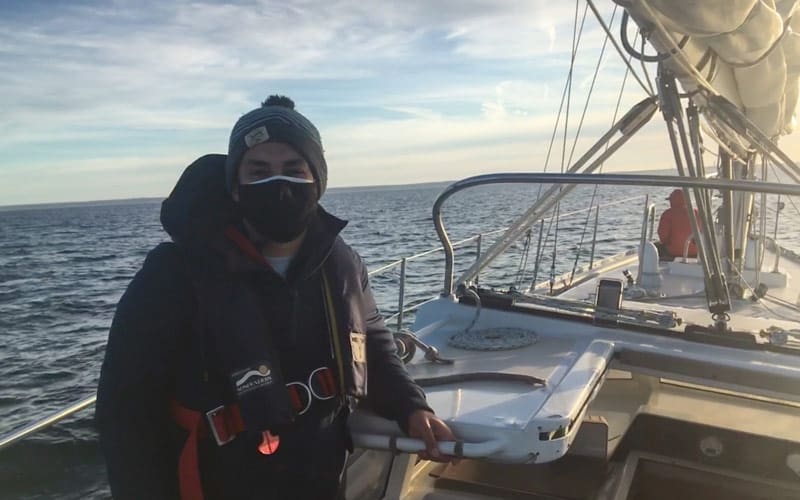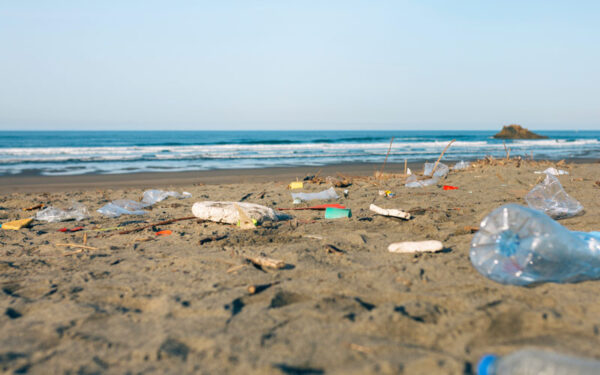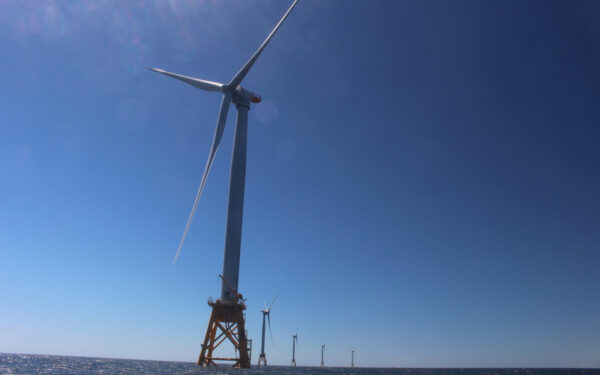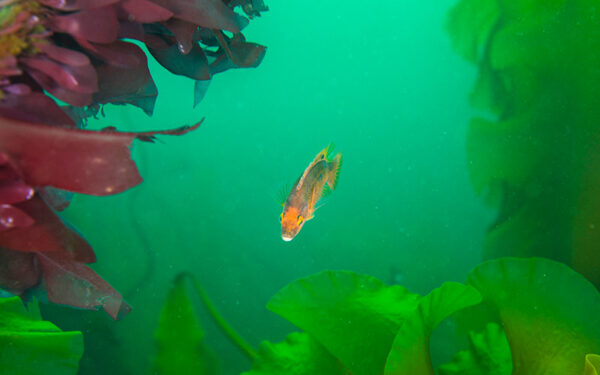
Adilson González Morales shares his experience encountering one of the rarest animals in the planet: the critically endangered North Atlantic right whale. Photo: Regina Asmutis-Silvia
Growing up in the arid desert of southwest Mexico, I dreamed of seeing the ocean. Yet, I never thought that one day, I would find myself sailing the Atlantic and encountering one of the rarest whales on the planet – the critically endangered North Atlantic right whale.
That encounter came about last year through a collaboration between CLF, National Geographic photojournalist Brian Skerry, and Michael Moore, a renowned marine biologist with Woods Hole Oceanographic Institution (WHOI). Together, we were working to capture photos of this magnificent species in its feeding grounds in Cape Cod Bay. When a spot opened up on the expedition boat, I didn’t think twice about tagging along with an incredible team of scientists searching for these precious whales.
Seeing a right whale is a once-in-a-lifetime opportunity
The night before the trip, the excitement kept me awake. For months, I had been reading about North Atlantic right whales, their life stories, and the many challenges that they have experienced for generations. I had grown increasingly passionate about their plight and the urgent need to save them, but with such few right whales left on the planet, seeing one in person seemed at best like a pipe dream. Today, scientists estimate the number of right whales to be fewer than 350 on the planet.
Sailing on a hopeful morning
The next morning, I got on the road at 6:00 am for the drive from my Boston home to the marina in Sandwich, Massachusetts, where Rosita, our sailboat, awaited.
The six-person crew layered up to endure the cold. Then, we loaded boxes with professional cameras, drones, and sophisticated instruments to record our potential whale sightings. As we sailed out into the sunrise, the captain received a radio report of a mom and calf sighting north of Provincetown. We hoisted the sails and set course in hopes of catching up to the pair.
If the mom and calf had made it to Cape Cod Bay, it meant that they had survived the harrowing journey from their winter feeding and calving grounds in the warm waters of Florida and Georgia. Every spring, the species makes its way up the busy Eastern Seaboard to the cool waters of Maine and Canada. They reach Cape Cod Bay around March and spend a couple of months in the area feeding, playing, and socializing.
Right whale at one o’clock
By noon, we had arrived at our destination. We began exploring the vast waters in the surroundings – waiting for the whales to give us a sign. Almost right away, Dr. Carolyn Miller, a researcher with WHOI, exclaimed in excitement, “I see a blow at one o’clock!” We steered the boat in that direction and began following the blow – which grew more prominent as we closed the distance.
As we approached, the gentle whoosh of the blow grew stronger. Then, we saw a fluke. It was indeed a North Atlantic right whale. Marylin Marx – New England Aquarium’s whale identification expert – quickly recognized the 16-year-old whale. “That’s Millipede,” she said as she pointed out the elongated propeller scar on the right side of the female whale’s body and the entanglement marks on her fluke – tragic signs of the dangers that right whales face from human-made threats today.
My chest overflowed with joy and astonishment at the sight of the dark body that surpassed the size – by far – of any living creature I had ever seen. Millipede’s beautiful black skin glistened as she spun around playfully. “She’s putting on quite a show,” said wildlife photographer Steve De Neef. Indeed, Millipede moved gracefully like a dancer on premiere night.
Every right whale calf brings hope for the future of the species
In the distance, a smaller blow appeared close to Millipede. It was her newborn – a calf that had already defied the odds by surviving the threats and dangers of its long trek from Florida.
I felt speechless – overwhelmed by the magnificence of this calf. Millipede’s baby was a light of hope for the future of the species itself.
But not every calf runs with the same luck. Back in 2012, Millipede gave birth for the first time, but that calf was never spotted again and scientists believe it may have perished.
What’s more, during this calving season only 15 calves were born. Snow Cone, one of the mothers from this season, became pregnant and gave birth while entangled. For over a year now, Snow Cone has carried a trail of thick, heavy rope ensnared on her mouth. Researchers have spotted her calf playing with the rope – swimming in, through, and around it.
Snow Cone’s first calf, born in 2020, survived only for a few months, as he died on impact when hit by a vessel off the coast of New Jersey.
While 15 calves may seem like a large number, it is not enough to save right whales from the brink of extinction. We need measures in the water that make the ocean safer for these calves to survive and for their mothers to be healthy enough to give birth and raise their babies.
How a scientific whale watching trip can help save a species
Watching Millipede and her calf play together, I stood in awe, but the crew did not have time to sit back and contemplate. The scientists on board instantly grabbed their gear – cameras, drones, fieldnotes, right whale catalogs, and GPS devices – to record the sighting.
Dr. Moore and Dr. Miller launched a drone high into the sky to capture footage to measure the whales’ length and width to determine their growth. Meanwhile, Marylin Marx continued to observe the pair, looking for new marks and scars on their bodies, scribbling down every detail she could record. On the other side of the boat, Steven De Neef photographed every jump, spin, blow, and interaction that the mother and the calf had.
Finally, the right whale pair went on their way. We changed course and continued the expedition. We spotted three other North Atlantic right whales before the sun went down – every encounter took my breath away just as much as the one before.
My message to North Atlantic right whales
A year has passed since I saw Millipede and her calf. I don’t know if I will ever see them or any of the other North Atlantic right whales again. But I hope I do, and I wish that, somehow, they knew what was happening on our boat that day.
I wish they knew that we deeply care about their future and that, beyond surviving, we want North Atlantic right whales to thrive and roam an ocean free from deadly threats.
But more than anything, I would like to tell right whales about the people on that boat and others who fight for them every day: the scientists, the photographers, the lawyers, the artists, the hundreds of advocates working to save this species – not to mention the many more people who read about them, share photos of them, and speak up on their behalf.
We have not given up on right whales, and I look forward to a day in the future when seeing one in the wild is not a rare sight but a reminder that we can make a difference.
Join us by learning more about the North Atlantic right whale and asking your elected officials for better protections for this species.
North Atlantic right whales are in New England waters now. We were able to get close to them because we were aboard a scientific vessel licensed by NOAA. If you see one, slow down and keep your distance. Federal law requires vessels, paddle boarders, and aircraft (including drones) to stay at least 500 yards away. You can also help by reporting whale sightings through the WhaleAlert app or via phone at 866.755.6622.
*Story updated on June 6th, 2022.




